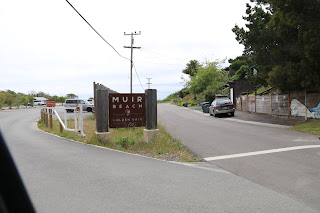Yesterday we took a tour of Alcatraz Island. It was Sunday slap dab in the middle of the Memorial Day weekend and the crowds and traffic were heavy. The parking garage cost us $20 for the day and after the tour we looked for a nice place to eat. Settled on a place across the street from the pier and had a $21 cheeseburger with fries. It was good and very thick, as it should be for $21.
Leaving San Francisco behind
Closing in on Alcatraz Island
The prison is the large building at the top of the island
Following the acquisition of California, the US Army began fortifying Alcatraz Island and by 1853 were guarding the harbor from Camp Alcatraz. At the height of the Civil War the island held over 100 heavy cannon ranging in size from 8 inch to 15 inch. The 15 inch gun weighted 50,000 pounds and could fire a 440 pound cannonball three miles.
One of the 10 inch cannons
The island is just a huge rock and had no soil. The army wives living on the island complained of not having soil for a garden so soil was transported from nearby Angel Island. Today there is a lot of vegetation on the island thanks to that soil.
Lots of vegetation today
In August 1934 the island became a federal prison and remained one until it was closed in 1963. On two different occasions the abandoned island was occupied by a group of Native Americans demonstrating against government polices toward Native Americans. The following photo of the water tank shows some of the graffiti left behind during the occupations.
Notice graffiti on water tank
The inmates of Alcatraz were allowed two showers a week and this photo shows the showers. Puts me in mind of my early days in the military where modesty had to be abandoned. I hated the row of toilets without any partition between seats.
Notice all the shower heads
A typical cell
One of the cell blocks
The old mess hass
In the photo of the old mess hall you may notice one of the devices in the next photo. There were many of these on the ceiling and they were tear gas canisters that were remotely controlled. They were never used.
One of many tear gas canisters
Mess hall menu
The old prison control room
As a Federal Prison Alcatraz was designed to hold prisoners who continuously caused trouble at other federal prisons. During its operation Alcatraz held some of the most notorious criminals in American history. To name a few, Al Capone, Robert Stroud (Birdman) and George "Machine Gun" Kelly.
Some of the famous inmates
There were numerous escape attempts from Alcatraz but only one may have been successful. Two brothers, Clarence and John Anglin, and Frank Morris spent at least a year planning and preparing for their escape. A fourth prisoner who was left behind because he was not ready was interviewed by the FBI to obtain many of the details of how the three escaped. The FBI maintains they drowned and were not successful but none of the three bodies have ever been found. If you google the escape you will find lots of interesting material to read. They fashioned a make shift raft out of raincoats. Here is the wikipedia link:
https://en.wikipedia.org/wiki/June_1962_Alcatraz_escape_attempt#Escape
In 1972 Alcatraz became part of the National Park System and today has over a million visitors each year. We noticed many of the visitors were from foreign countries and were surprised they would be interested in a retired US Federal Prison.




















































